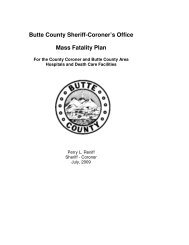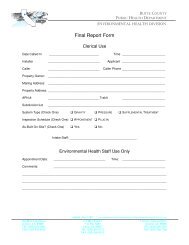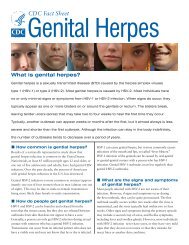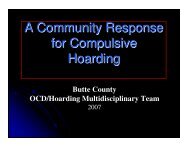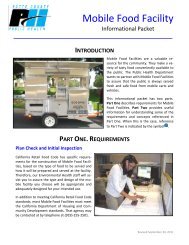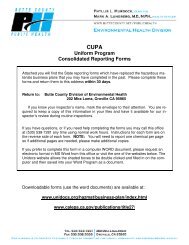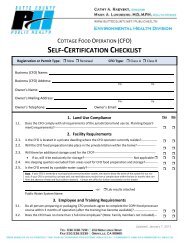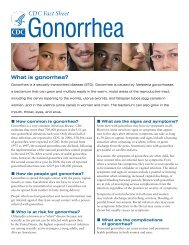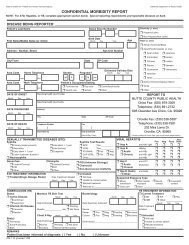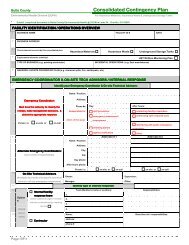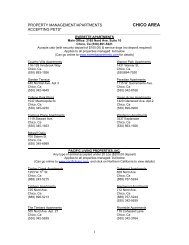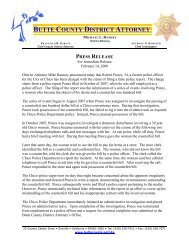Spill Prevention, Control, and Countermeasure - US Environmental ...
Spill Prevention, Control, and Countermeasure - US Environmental ...
Spill Prevention, Control, and Countermeasure - US Environmental ...
You also want an ePaper? Increase the reach of your titles
YUMPU automatically turns print PDFs into web optimized ePapers that Google loves.
SPCC Rule Amendments Delay of Effective Date January 2009<br />
• Amends the general secondary containment requirement;<br />
• Exempts non-transportation-related tank trucks from sized secondary containment<br />
requirements;<br />
• Amends the facility security requirements to allow the facility owner/operator to tailor security<br />
measures to the facility’s specific characteristics <strong>and</strong> location; <strong>and</strong><br />
• Amends integrity testing requirements for bulk storage containers to allow greater flexibility in<br />
the use of industry st<strong>and</strong>ards at all facilities.<br />
What sector-specific changes did EPA finalize<br />
Agriculture. The rule exempts pesticide application equipment <strong>and</strong> related mix containers that may<br />
currently be subject to the SPCC rule when crop oil or adjuvant oil are added to formulations. The rule<br />
exempts farms from loading rack requirements. EPA also clarifies that a nurse tank is considered a mobile<br />
refueler, <strong>and</strong>, like other types of mobile refuelers, is exempt from the sized secondary containment<br />
requirements. Additionally, farms are likely to benefit from several of the other amendments finalized in<br />
this rule.<br />
Oil Production Facilities. The revised rule finalizes several amendments to tailor the requirements<br />
for oil production facilities. The rule:<br />
• Modifies the definition of production facility;<br />
• Extends the timeframe by which a new oil production facility must prepare <strong>and</strong> implement an<br />
SPCC Plan;<br />
• Establishes alternative criteria for certain marginal, oil production facilities to be eligible to selfcertify<br />
an SPCC Plan as a qualified facility;<br />
• Exempts certain produced water containers <strong>and</strong> any associated piping <strong>and</strong> appurtenances<br />
downstream from the container that do not contain oil in harmful quantities, as certified by a<br />
PE;<br />
• Exempts production facilities from loading rack requirements;<br />
• Provides an alternative option for flow-through process vessels to comply with the general<br />
secondary containment requirement <strong>and</strong> additional oil spill prevention measures in lieu of<br />
sized secondary containment requirements;<br />
• Exempts certain intra-facility gathering lines subject to the U.S. Department of<br />
Transportation’s (DOT’s) pipeline regulations;<br />
• Provides an optional exemption from all secondary containment requirements for flowlines<br />
<strong>and</strong> intra-facility gathering lines, <strong>and</strong> establishes more specific requirements for a<br />
flowline/intra-facility gathering line maintenance program <strong>and</strong> contingency planning;<br />
• Provides compliance alternatives to sized secondary containment for produced water storage<br />
containers that are not otherwise exempt; <strong>and</strong><br />
• Clarifies the definition of “permanently closed.”<br />
Animal Fats <strong>and</strong> Vegetable Oils. EPA has amended the integrity testing requirements for<br />
containers storing certain types of animal fat or vegetable oil, to provide the flexibility to determine the<br />
scope of integrity testing that is appropriate, based on compliance with certain FDA regulations <strong>and</strong><br />
other criteria.<br />
Qualified Facilities. EPA streamlined <strong>and</strong> tailored the SPCC requirements for a subset of qualified<br />
facilities. The owner or operator of a qualified facility has the option to self-certify his SPCC Plan <strong>and</strong><br />
comply with other streamlined requirements. This final rule designates a subset of qualified facilities<br />
(“Tier I qualified facilities”) as those that meet the current qualified facilities eligibility criteria <strong>and</strong> that<br />
have no individual aboveground oil storage containers with a capacity greater than 5,000 U.S.<br />
Office of Emergency Management



